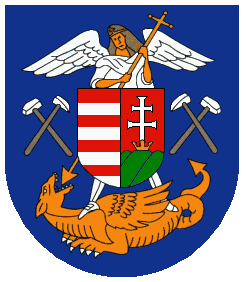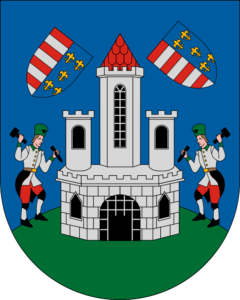The Mining Towns of Upper Hungary

The Mining Towns’ District (or Captaciancy) of Upper Hungary was a critical area that was the wishful target of Ottoman raids. It is no wonder because those mines provided so much riches, two-thirds of Europe’s gold was coming from there, not to mention the silver production that provided one-fourth of what Europe needed. In the modern age (after 1918), this area is in Slovakia.
Almost all the minted money of the Hungarian Kingdom was coming from there because the rest of the mining towns were located in the Transylvanian Principality. (Romania, after 1918)

Beginning with the Fuggers to the Habsburgs everybody needed them, the desire for their ownership was one of the reasons why the Hungarian Kingdom fell in 1526. Their gold, silver, and copper mines provided an innumerable amount of resources to Europe.
Naturally, the Hungarian Kingdom relied on the production of the richest mines in Europe which were located in the Carpathian Basin and poured immense quantities of silver, copper, and gold.
It was King Károly Róbert in the 14th century who gave the first privilege to these towns: anyone had the right to launch a mine and they had to pay taxes only to the Hungarian king.
King Matthias Corvinus took good use of them, these towns were developing quickly because of their miners and gold- and silver production; the minting and all the work of issuing coins was done there. The king received fixed sums annually from there. It was quite easy for a peasant to go to live there as the taxes were not smaller there, either. The towns were directly under the control of Matthias` Treasurer.

The free royal towns were Bakabánya, Besztercebánya, Bélabánya, Körmöcbánya, Libetbánya, Selmecbánya, Újbánya (located on the lower side of the area) while Nagybánya was in Transylvania in Szatmár County.
The next towns were so-called “privileged mining towns”: Gölnicbánya, Szomolnok, Igló (in Szepes County) while Felsőbánya was in Transylvania in Szatmár County.
The following mining towns were under the control of local landlords or owned by the Church: Körösbánya, Jászó, Rézbánya, Rozsnyó, Rudabánya, Telkibánya.
The so-called Mining Towns of Lower Hungary (which area was also part of the Upper Lands) were Körmöcbánya, Selmecbánya, Besztercebánya, Újbánya, Bakabánya, Libetbánya, Bélabánya, Breznóbánya.
The Mining Towns which belonged to the Highland Area were Szomolnok, Merény, Szepesremete, and Gölnicbánya.

The Fuggers and the Mining Towns
Some people say Hungary was lost in 1526 because the Fuggers needed these mines back quite badly. Right before the Battle of Mohács, there was no money in the wealthy Hungarian Kingdom. First of all, the Hungarian barons can be made responsible for weakening the king’s power. The fall of Nándorfehérvár (Belgrade) in 1521 was due to fraud: the money sent to the garrison of Belgrade had miraculously disappeared so the Turks could take it. The country’s gate stood open to the Ottomans.

As for the financial crisis, Szerencsés Imre (Fortunatus aka Snéor ben Efraim), the vice treasurer, had been involved in the financial chaos of the country. When Fortunatus was accused in 1525 of fraud, he blamed it on the Fugger banking family.
It is true, that the Fuggers wanted to recover the mining rights of the rich Hungarian Mining Towns that King Louis had taken away from them. They didn’t need to wait for a long time, though.
Here you can watch an animation video of the Battle of Mohács in 1526:
https://www.hungarianottomanwars.com/videos/the-battle-of-mohacs-1526/
Let us see one of the mining towns more closely, Besztercebánya:
Besztercebánya (Neusohl or Banská Bystrica) – a mining town
The town prospered because of the abundant copper ore in its mines. The copper business began to thrive when Count Thurzó Elek and his descendants were in charge of the city. They gained enormous wealth from the mining towns of the Upper Lands of Hungary.

The Thurzós’ success was multiplied when they intermarried with the Fugger banker family. The affluent Fugger and Thurzó families founded the prosperous Ungarischer Handel company (German for “Hungarian Trade”) in 1494 which became a leading world producer of copper by the 16th century. With the most sophisticated mining technologies in Europe, an advanced accounting system, and benefits including medical care for its 1,000 employees, Ungarischer Handel was one of the largest and most modern of the early-capitalist firms.
They were also involved in the selling of Hungarian gray cattle herds to feed Germany but later they decided to invest their money into the slave trade in North America.
Read about Hungarian grey cattle here:
https://www.hungarianottomanwars.com/essays/hungarian-grey-cattle/

See many pictures of Besztercebánya here:
https://www.hungarianottomanwars.com/kingdom-of-hungary/besztercebanya/
An early record of the miners’ industrial action in Besztercebánya is from 1526 when the City Council needed to take refuge within the confines of the city castle. Before the Battle of Mohács in 1526, the Fuggers retained 80% of the mining profit, 10% went to the Thurzó family and 10% arrived in the treasury of the king unless the Vice-Treasurer stole it.

When King Lajos (Louis) II of Hungary and Bohemia deprived them of their mining rights in 1525. In answer to that, the Fuggers removed all of the mining equipment from the mines of Besztercebánya as well as from the other mines. They even withdrew all of the professional local miners so that the king could not raise funds for his wars against the Ottoman invasion. Nobody was allowed to mess with the Fuggers without punishment. Finally, the king had to give the mines back to them. But the Fuggers never forgave him. When King Lajos needed loans to hire mercenaries against the Turks, the Fuggers used their powerful influence to block his attempts.

When King Lajos died at Mohács in 1526, the kingdom had two kings… It was the Dual Kingship period when King Habsburg Ferdinand and King Szapolyai ruled. During the Dual Kingship, King Habsburg Ferdinand took control of the mining cities. The Fugger’s men worked again in Besztercebánya, and copper production was resumed. Let us not forget, that Emperor Charles V, the brother of Habsburg Ferdinand was in great debt to the Fuggers because the Fuggers had bought him his imperial title.
Had the Mining Towns declined before the Ottoman peril, perhaps the Kingdom of Hungary would not have been attacked so vehemently by the Habsburgs after the Battle of Mohács in 1526?

I was collecting a few coats of arms of these “Bányavárosok” ( Mining towns):
Dear Readers, I can only make this content available through small donations or by selling my books or T-shirts.
If you like my writings, please feel free to support me with a coffee here:
You can check out my books on Amazon or Draft2Digital, they are available in hardcover, paperback, or ebook:
https://www.amazon.com/dp/198020490X
or at https://books2read.com/b/boYd81


My work can also be followed and supported on Patreon: Become a Patron!http://Become a Patron!









